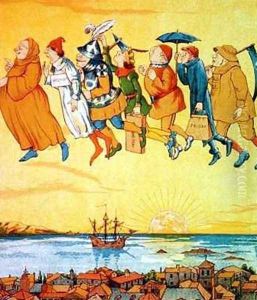George R. Halkett Paintings
George Roland Halkett, born in 1855, was a multifaceted Scottish artist whose contributions spanned across painting, illustration, and writing. His artistic journey was deeply influenced by the cultural and intellectual milieu of 19th century Scotland, a period marked by a rich artistic renaissance and a burgeoning interest in the arts and literature. Halkett's work, however, remains relatively obscure in the broader narrative of art history, despite his considerable talents and contributions.
Educated in Edinburgh, Halkett was part of a vibrant community of artists and intellectuals. Although specific details about his education are scarce, it is evident from his diverse body of work that he possessed a profound understanding of both classical and contemporary art forms. Halkett's paintings, characterized by their attention to detail and sensitivity to light and color, reflect the influence of the Pre-Raphaelite Brotherhood, with whom he shared a penchant for realism and a fascination with medieval themes and aesthetics.
Apart from his paintings, Halkett was also recognized for his illustrations and literary contributions. He illustrated several books, infusing them with his distinct style that captured the imagination of readers. As a writer, he engaged with the art and cultural debates of his time, contributing articles and essays to various periodicals. These writings not only provide insights into his artistic philosophy but also reflect the broader artistic and intellectual currents of his era.
Despite his talents, George R. Halkett did not achieve widespread fame during his lifetime, and his death in 1918 saw him remembered more by a circle of peers and aficionados than by the public at large. The reasons for this relative obscurity are manifold, including the changing tastes of the art world and perhaps the eclectic nature of his work, which straddled multiple disciplines. In the years following his death, Halkett's contributions have been periodically revisited by scholars and enthusiasts, who have recognized his work's intrinsic value and its reflection of the rich cultural tapestry of 19th century Scotland.
Today, George R. Halkett's legacy is that of a talented artist who navigated the intersections of painting, illustration, and writing with a unique vision. His works, though not as widely known as those of his contemporaries, offer a fascinating glimpse into the artistic endeavors and intellectual pursuits of his time. As art history continues to broaden its scope, artists like Halkett are gradually being re-evaluated, allowing for a more inclusive and diverse understanding of the past and its myriad voices.


